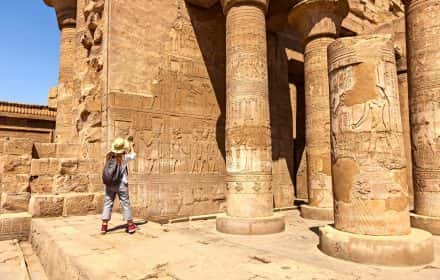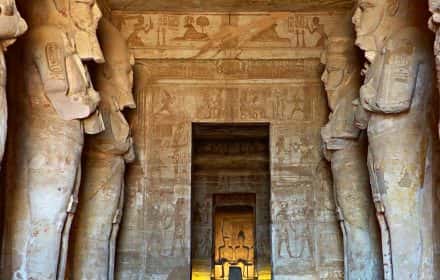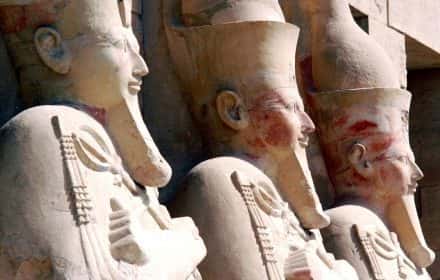This site uses affiliate links, meaning that if you make a purchase through our links, we may earn an affiliate commission.
The Temple of Philae, gracefully poised on Agilkia Island in Aswan, is an undisputed highlight for those exploring the wonders of Egypt.
However, embarking on a visit to the Temple of Philae can be an overwhelming endeavor, for within its sacred precincts lies an architectural treasure trove spanning from the days of the Pharaohs to the reign of the Caesars.
In this enchanting destination, history unveils itself layer by layer, revealing a captivating tapestry of ancient civilizations.
In this blog post, we will be your guides on this exhilarating journey through time and architecture as we explore the Temple of Philae in Aswan.
We will not only provide insights into how to embark on this unforgettable adventure but also share invaluable tips on what to see, ensuring that your visit to this monumental site is both enriching and awe-inspiring.
- 1. Navigating the Path to Philae: Location and Directions
- 2. Captivating Facts About the Temple of Philae
- 3. Map of the Temple of Philae
- 4. What to See at the Temple of Philae in Aswan - 9 Amazing Things You Can't Miss
-
- 4.1. The Vestibule of Nectanebo I
- 4.2. The Outercourt and the Colonnades
- 4.3. The First Pylon of the Temple of Philae Complex
- 4.4. The Forecourt and the Birth House (Mammisi)
- 4.5. The Second Pylon
- 4.6. The Vestibule
- 4.7. The Sanctuary of the Temple of Isis
- 4.8. The Temple of Hathor
- 4.9. The Kiosk of Trajan (Pharaoh's Bed)
- 5. Intrepid Scout's Tips for How to Visit and What to See at the Temple of Philae
Navigating the Path to Philae: Location and Directions
The Temple of Philae Complex is located on Agilkia Island (also called Agilika). Agilkia Island is situated in the reservoir of the Old Aswan Dam (also called Aswan Low Dam).
Source: Map data @2020 ORION_ME
My transportation to the Temple of Philae and my guide were done through the travel agency: Your Egypt Tours. They worked with me to put together a 7-day Egypt itinerary.
For my trip to see the Temple of Philae, my guide picked me up from the airport in Aswan, and off we went to see the Temple of Philae located on the island of Agilkia.
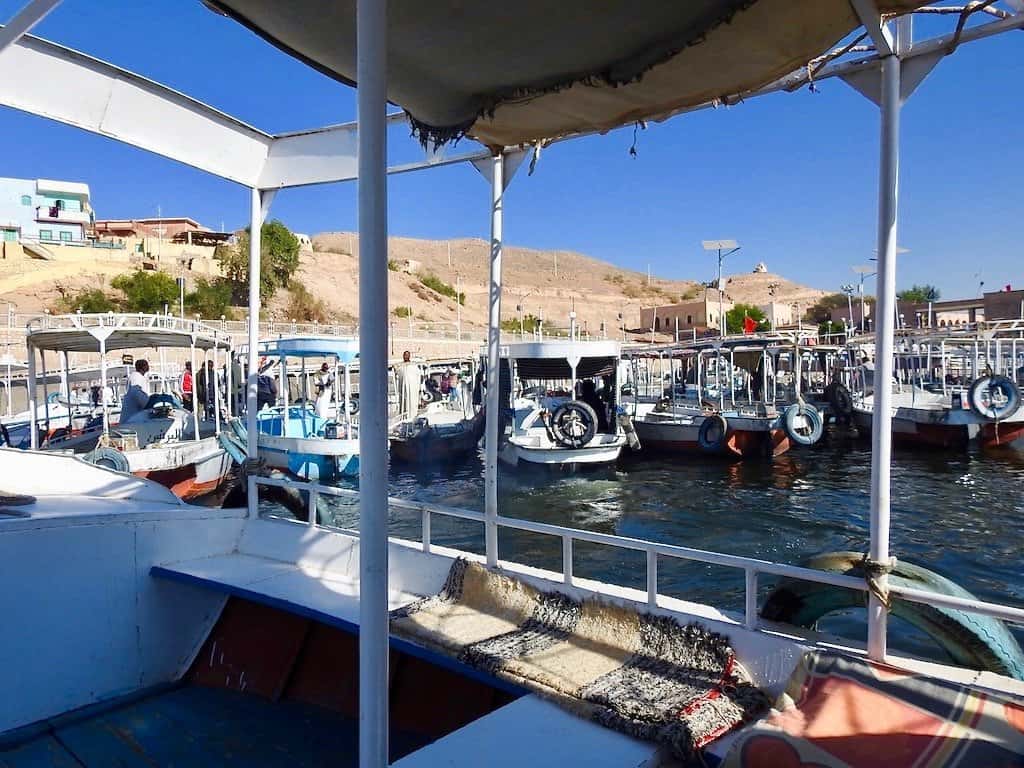
Marina Philae Temple / How to Visit and What to See at the Temple of Philae
It took about 20 minutes to reach the Marina Philae Temple, where small boats wait to transport visitors to Agilkia Island where the Temple of Philae Complex is located.
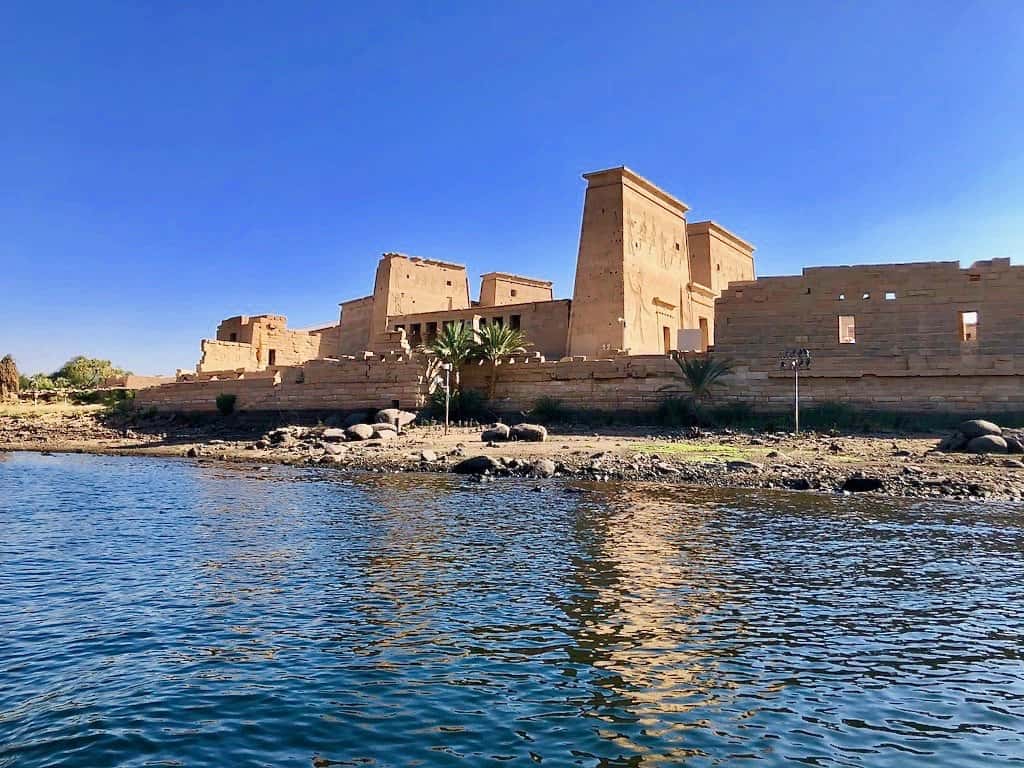
Temple of Philae on Aglikia Island / How to Visit and What to See at the Temple of Philae
Captivating Facts About the Temple of Philae
The Temple of Philae holds a place of profound significance in the annals of Egyptian history for several compelling reasons.
Firstly, it resided on Philae Island, a site steeped in myth and legend, believed to be one of the sacred burial grounds of Osiris, the god of the afterlife and rebirth.
Secondly, the temple was an eloquent tribute to the goddess Isis, the devoted wife of Osiris and the nurturing mother of Horus, marking it as a hallowed place of divine devotion.
This sacred edifice endured as a center of veneration across numerous epochs, commencing during the Ptolemaic Kingdom period and extending through the Aegyptus era, reaching its zenith during the Coptic period.
Pilgrims from lands far and wide across the Mediterranean made the arduous journey to Philae, drawn by their deep reverence for the goddess Isis and the spiritual aura that enveloped this sanctuary.
However, the fate of Philae Island took a tumultuous turn with the construction of the Old Aswan Dam in 1902, commonly known as the Aswan Low Dam.
This dam led to the flooding of Philae Island and its temple complex for a significant portion of the year, threatening the very existence of this treasured site.
The situation grew even direr when plans for a second dam were unveiled in 1954, casting a shadow over the island’s future.
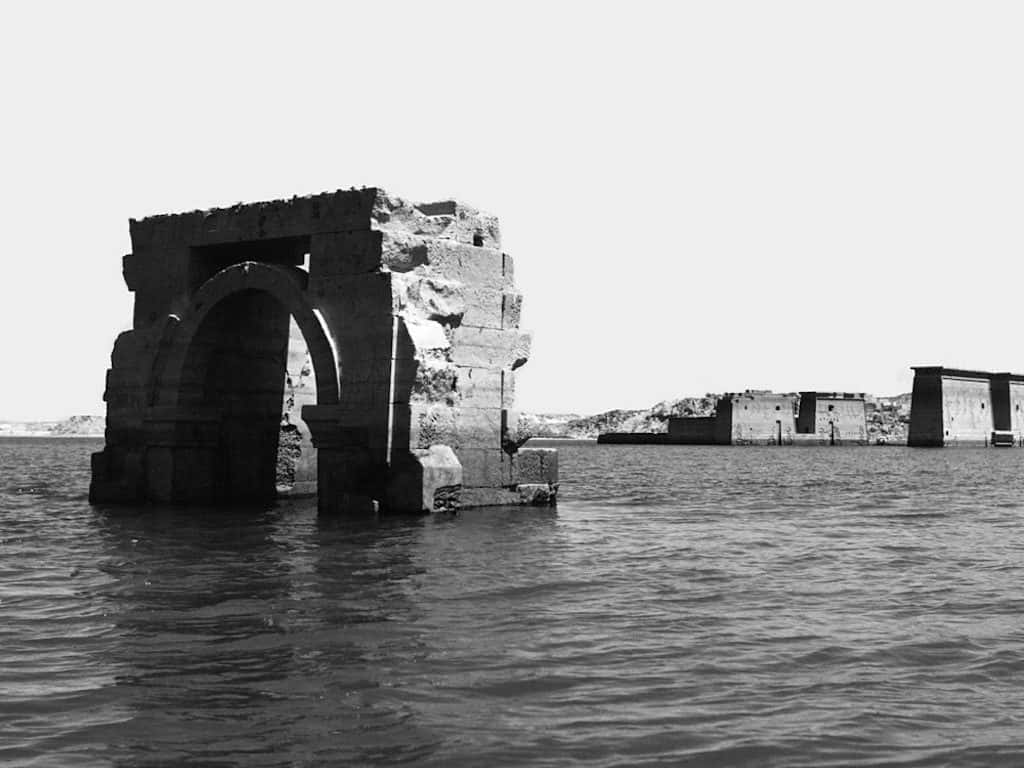
Temple of Philae before being moved to the Island of Aglikia / How to Visit and What to See at the Temple of Philae / Image Credit: Wikipedia Commons
In a remarkable turn of events, the international community rallied to save the Nubian monuments, with UNESCO spearheading the charge in 1960.
Eight years later, a momentous decision was reached: the Temple of Philae, along with other monuments, would be painstakingly dismantled, moved, and meticulously reconstructed on the island of Agilkia, situated 500 meters away. This bold endeavor ensured the preservation of the temple’s grandeur and historical significance for generations to come.
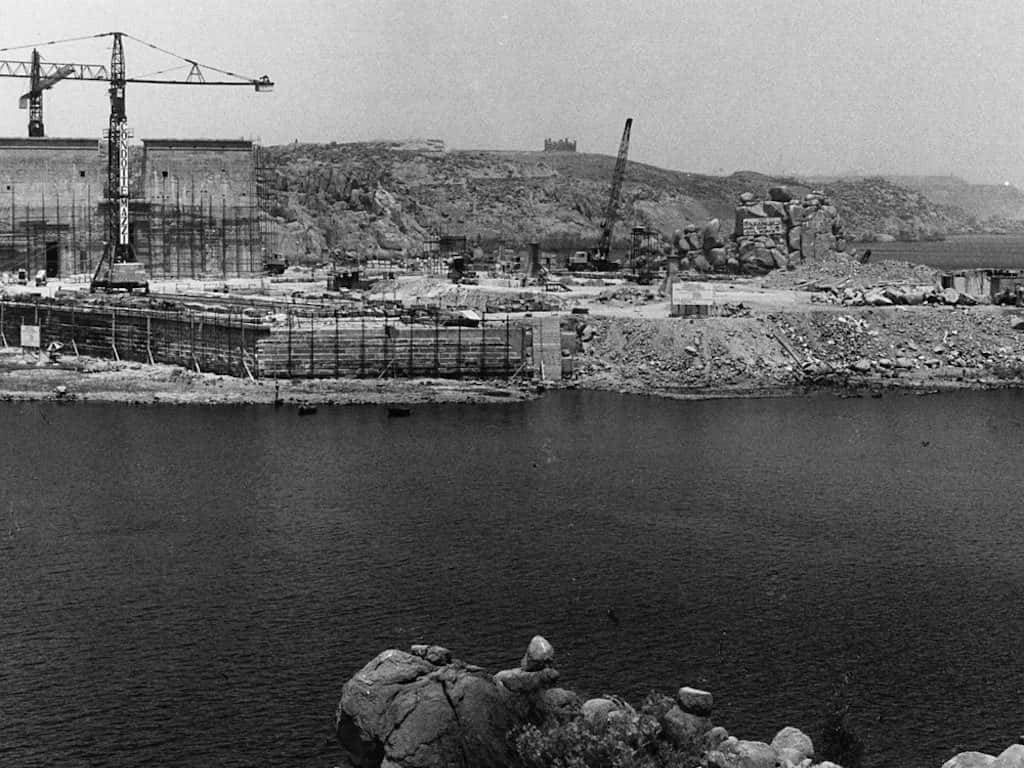
Reconstruction of the Temple of Philae / How to Visit and What to See at the Temple of Philae / Image Credit: Wikimedia Commons
Notably, the meticulous process of measuring the monuments before their relocation relied on the cutting-edge science of photogrammetry, a technique that involves making precise measurements from photographs.
This innovative approach played a pivotal role in ensuring the temple’s faithful reconstruction, preserving not just its physical structure but also its timeless spiritual essence.
Map of the Temple of Philae
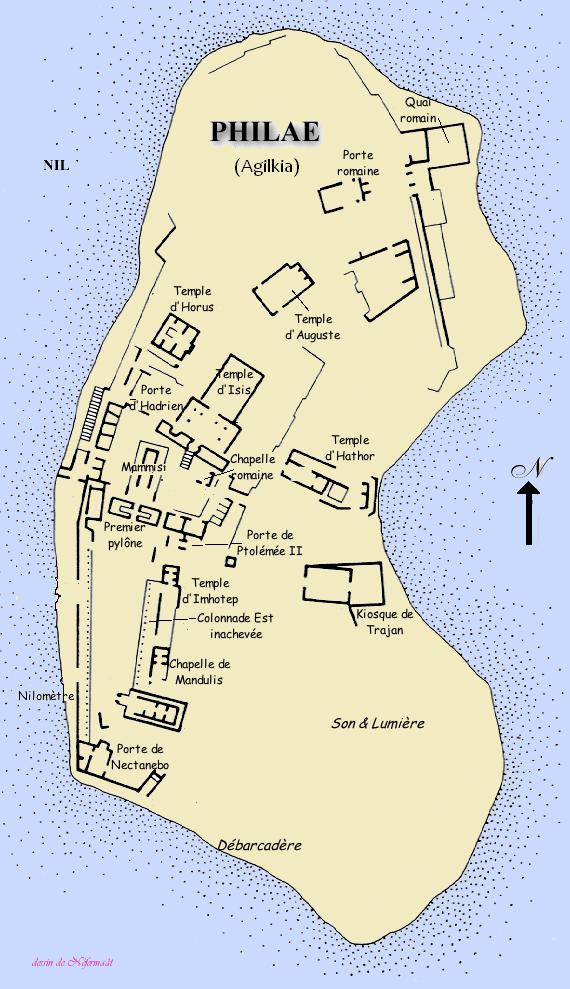
Image Credit: Gérard Ducher via Wikimedia Commons
1 . The Vestibule of Nectanebo I
2. The Outercourt and the Colonnades of the Temple of Philae
3. The First Pylon of the Temple of Philae Complex
4. The Forecourt of the Temple of Philae and the Birth House (Mammisi)
5. The Second Pylon
6. The Vestibule of the Temple of Philae
7. The Sanctuary of the Temple of Isis
8. The Temple of Hathor
9. The Kiosk of Trajan (Pharaoh’s Bed)
What to See at the Temple of Philae in Aswan - 9 Amazing Things You Can't Miss
The Vestibule of Nectanebo I
The Vestibule of Nectanebo I stands as a captivating architectural masterpiece, characterized by its graceful columns interconnected by elegant screen walls.
While this vestibule originally boasted a total of 14 columns, the passage of centuries has seen the erosion of time, leaving only 6 of these splendid pillars standing in silent testament to the past.
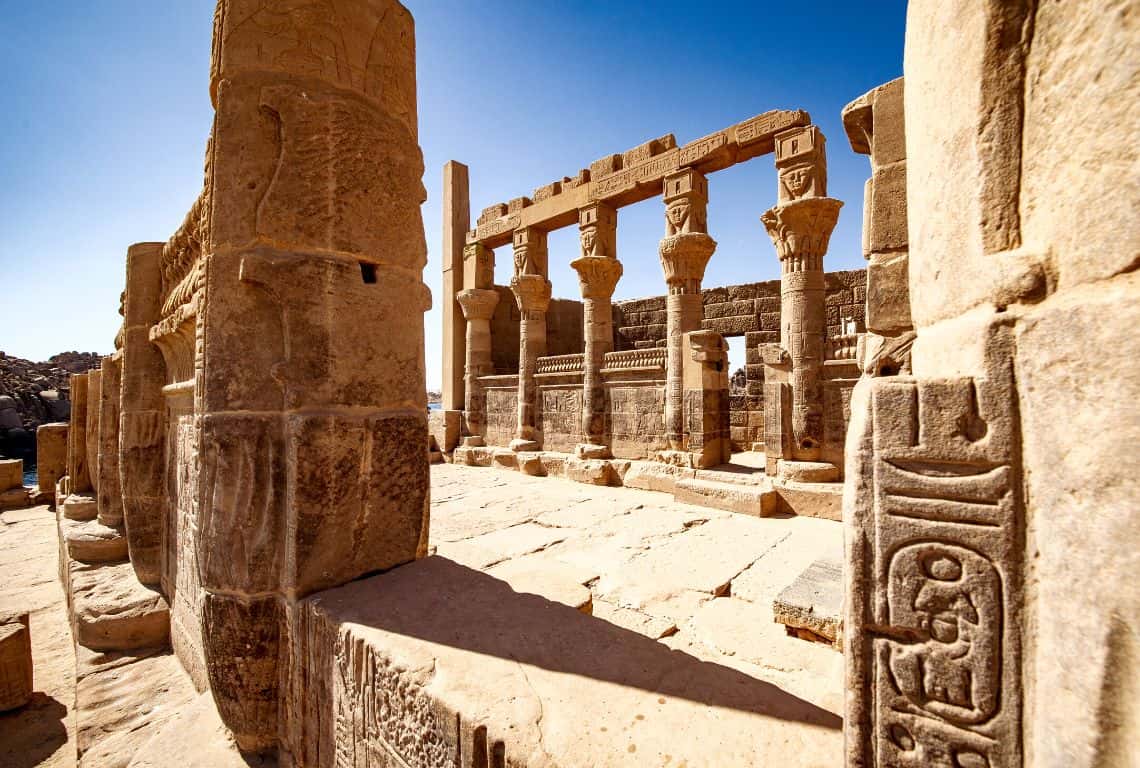
The Vestibule of Nectanebo I / How to Visit and What to See at the Temple of Philae
A striking feature that adorns these columns is the presence of the goddess Hathor, whose visage graces each side. This unique configuration is emblematic of Hathor’s profound influence, signifying her divine reach across all four corners of the world.
Each column bears the distinctive cartouche bearing the name of Nectanebo I, a notable figure in Egyptian history.
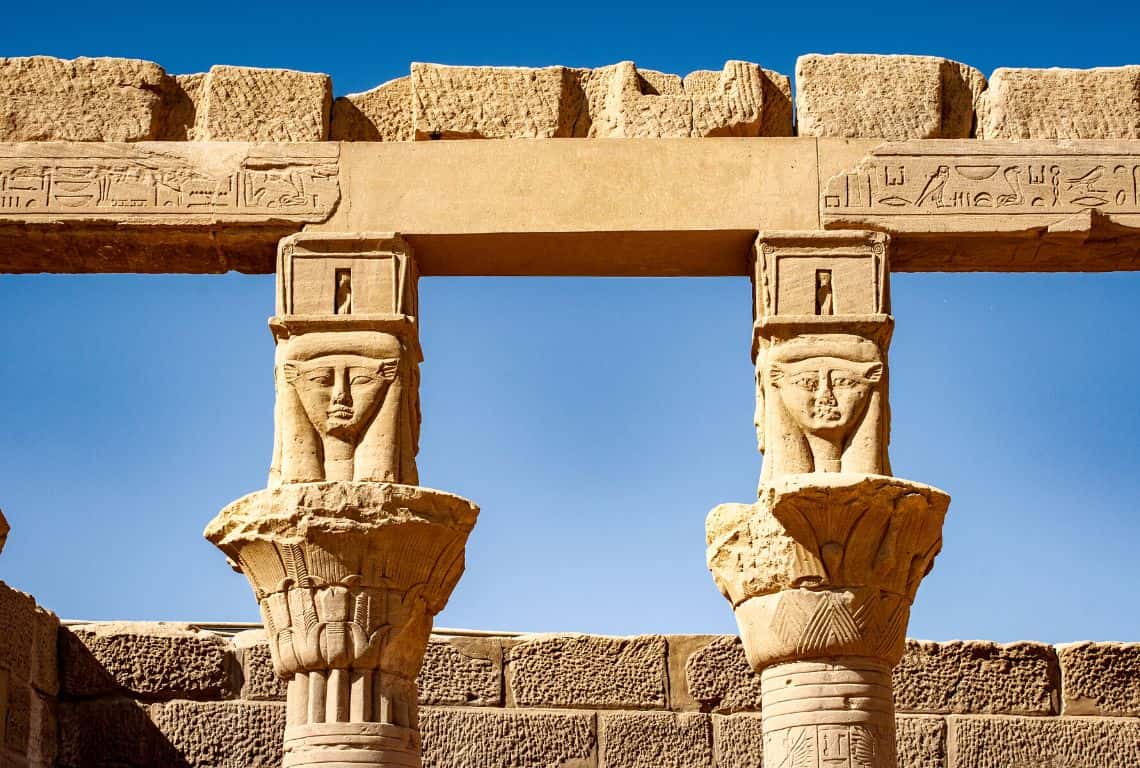
The Vestibule of Nectanebo I / How to Visit and What to See at the Temple of Philae
Nectanebo I ascended to the throne of Egypt and ruled with distinction from 381 to 362 B.C.E.
During his reign, Egypt faced a pivotal moment when the Persians attempted to regain control of the region in 373 B.C.E. In a remarkable display of strategic prowess, Nectanebo I skillfully outmaneuvered the formidable Persian army of 220,000 troops near Mendes in the Nile delta, compelling their retreat.
This triumphant defense significantly reduced the external threat to Egypt, as the Persian kings became preoccupied with rebellions across their vast empire.
Beyond his military acumen, Nectanebo I emerged as a devoted patron of the arts.
His reign witnessed an ambitious building program, leaving an indelible mark on iconic sites such as Philae, Edfu, and Hermopolis Magna.
In 380 B.C.E., the pharaoh made a historic proclamation by dedicating a monumental stone marker at the thriving harbor of Herakleion. This declaration officially recognized Herakleion as the Nile’s gateway to the Mediterranean Sea, underscoring Egypt’s pivotal role in regional commerce and maritime activities.
Nectanebo I’s legacy endures not only through the enduring architecture of his time but also through his strategic leadership and cultural contributions that have left an indomitable imprint on Egypt’s rich history.
The Outercourt and the Colonnades
As you step into the Outercourt of this grand temple complex, prepare to be enveloped by the enchanting presence of two remarkable colonnades that flank your path.
The western colonnade, tracing the island’s edge, is a testament to both precision and individuality. A closer examination reveals a captivating detail: each column capital stands as a unique work of art, showcasing the artisans’ mastery and creativity.
No two capitals on the western side share the same design, attesting to the skilled craftsmanship that graced this sacred space.
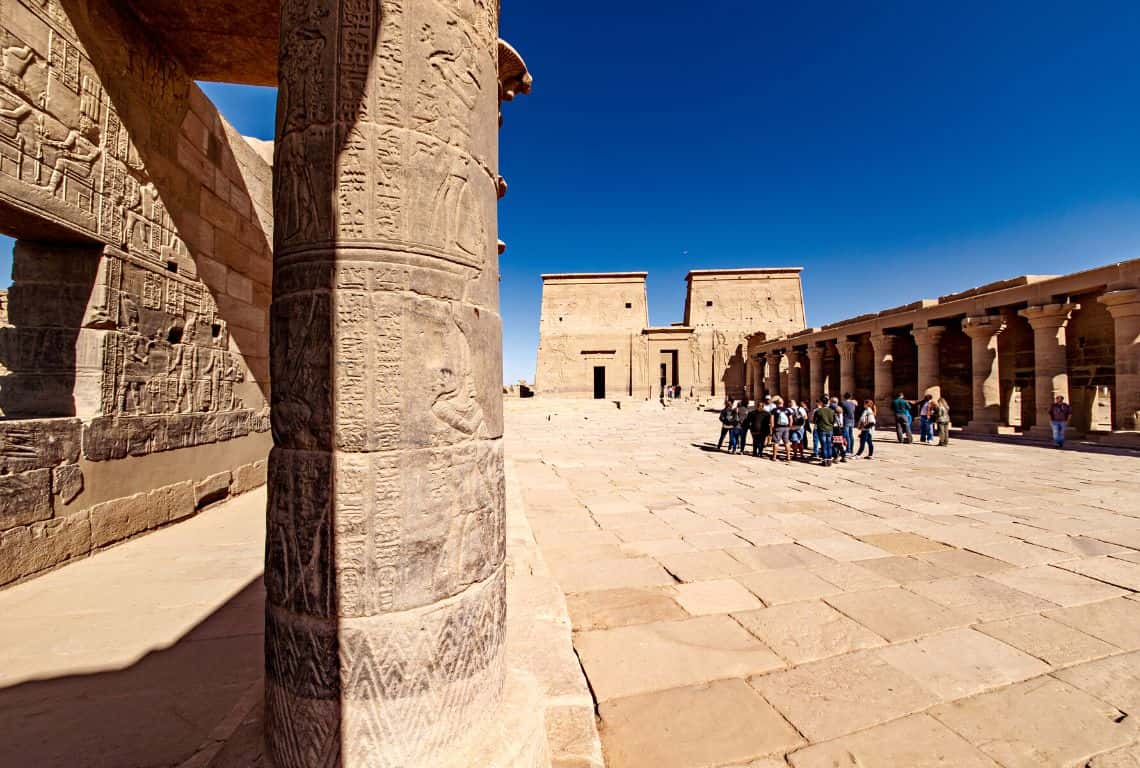
The Outercourt and the Colonnades / How to Visit and What to See at the Temple of Philae
On the contrasting eastern side, you will encounter a different narrative. Here, the colonnade wears an unfinished aspect, hinting at a story left untold by the hands of time.
The eastern colonnade’s incompleteness serves as a silent testament to the challenges and mysteries that surround the temple’s construction, offering visitors a tangible glimpse into the past and the ever-evolving nature of history.
The First Pylon of the Temple of Philae Complex
As you approach the imposing First Pylon of the Temple of Philae Complex, a journey through time and artistry unfolds before your eyes. Here, history intertwines with intricate reliefs and enigmatic remnants, inviting you to delve deeper into the past.
Gaze upon the remnants of the once-proud obelisks, now mere echoes of their former glory, silently guarding the entrance. Only a pair of resilient granite lions remains steadfast sentinels at this hallowed threshold.
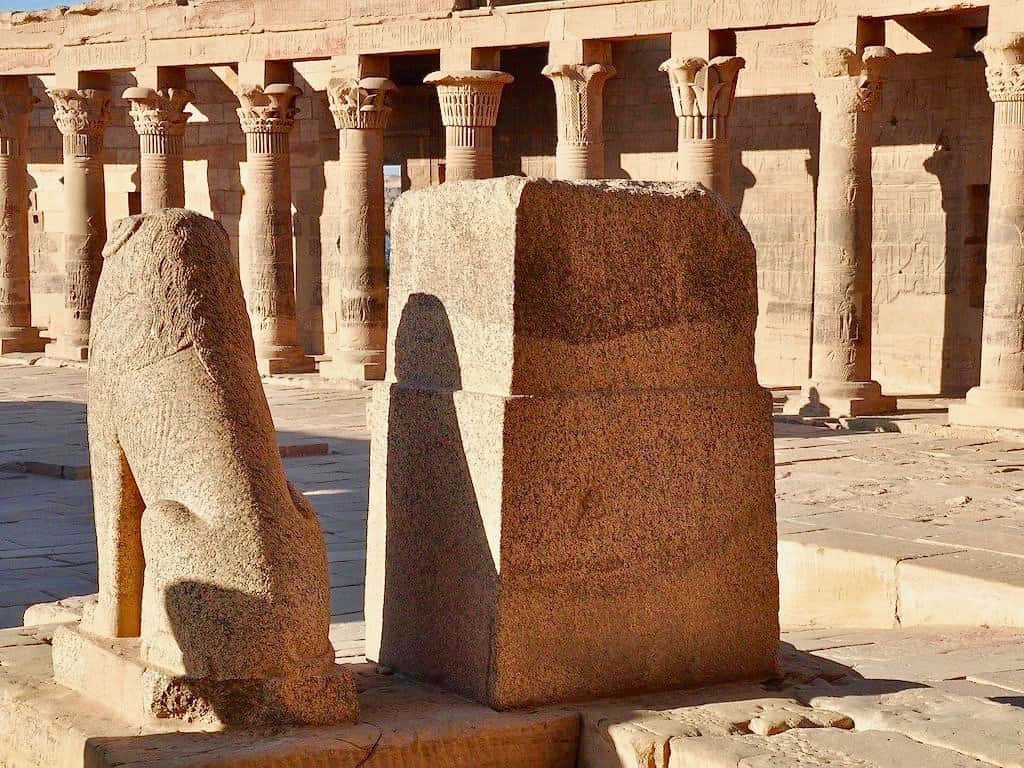
The First Pylon of the Temple of Philae / How to Visit and What to See at the Temple of Philae
This gateway, comprising two soaring towers each standing at a commanding 18 meters in height, beckons you with stories etched in stone.
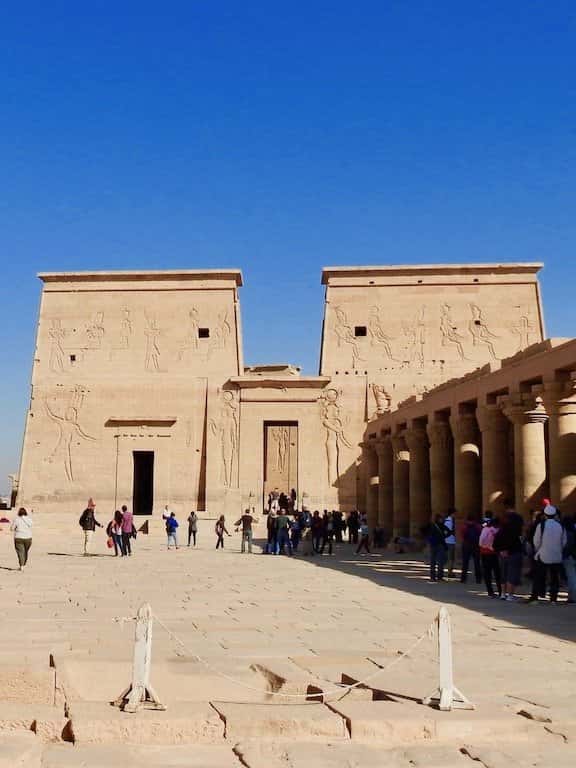
The First Pylon of the Temple of Philae / How to Visit and What to See at the Temple of Philae
On the western tower, you will encounter the indelible relief of Ptolemy XII Neos Dionysos, also known as Auletes, a powerful image as he firmly grasps a cluster of his adversaries by their hair, poised to strike them down with his raised staff.
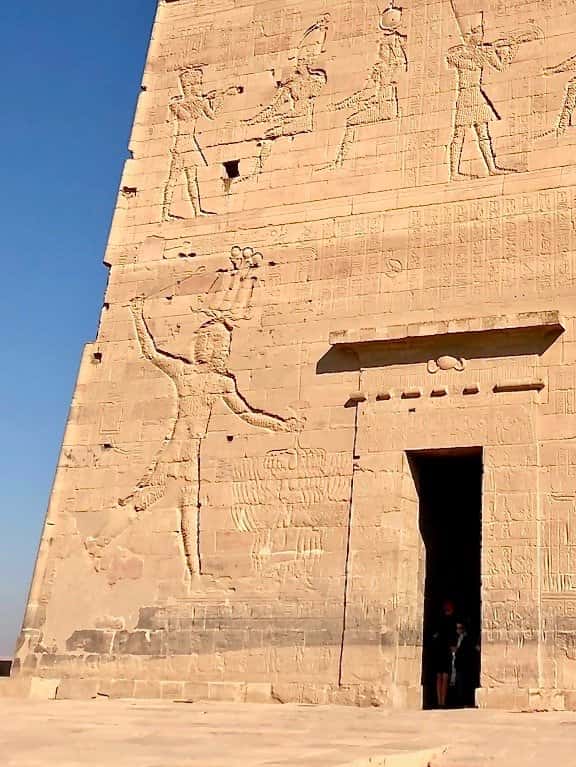
The First Pylon of the Temple of Philae / How to Visit and What to See at the Temple of Philae
Venture through the door in the western tower, and you will step into another celebrated structure: the Birth House, a subject we will delve into in the forthcoming section of our journey.
Now, direct your attention to the eastern tower, where a spectacular tableau unfolds. Here, magnificent reliefs pay homage to the goddess Isis and the revered falcon-headed god Horus.
Above these captivating depictions, you will find more layers of symbolism and history.
On the right, a relief portrays Ptolemy XII Neos Dionysos offering the crowns of Upper and Lower Egypt to the watchful deities Horus and Isis. To the left, Ptolemy is depicted once again, this time presenting incense to Isis and, as local lore has it, to Harpocrates, adding an intriguing layer of mystique to the narrative.
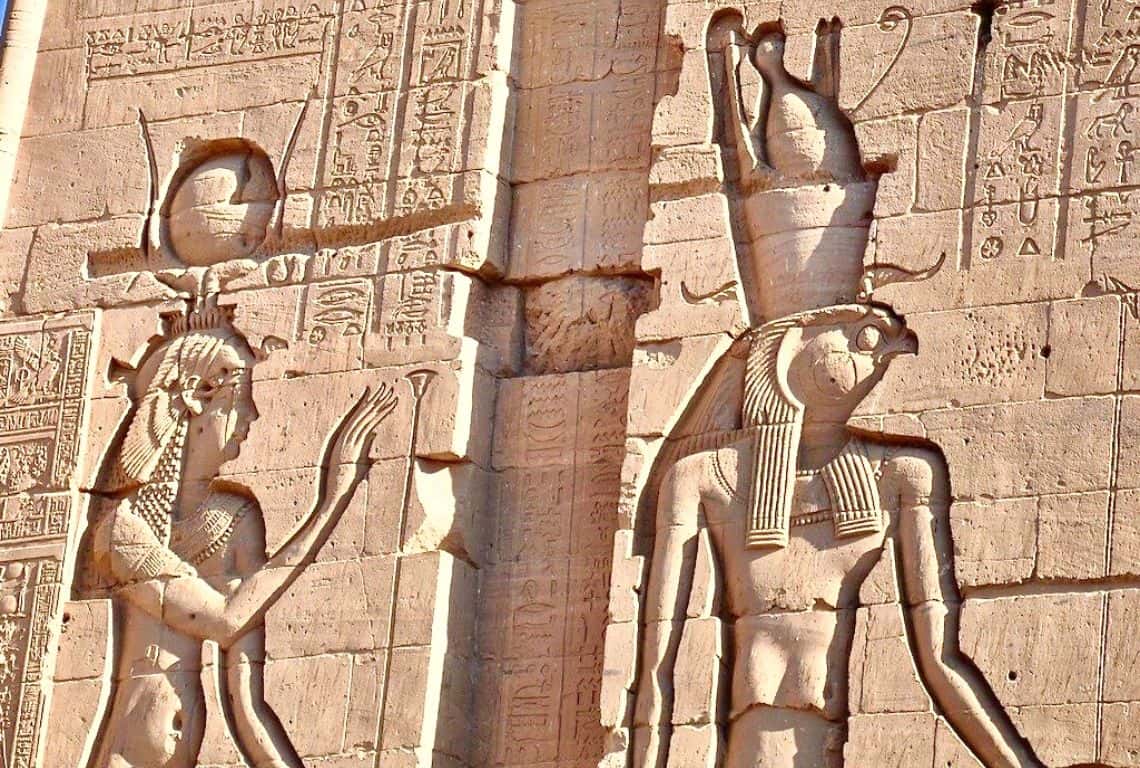
The First Pylon of the Temple of Philae / How to Visit and What to See at the Temple of Philae
As you pass through the grand entrance of the first pylon, take a moment to study the walls adorned with inscriptions commemorating Napoleon’s historic campaign.
These inscriptions etch a poignant chapter into the temple’s history. Keep an eye out for an inscription that pays tribute to General Desaix, highlighting his triumph over the Mamelukes at Behneceh and subsequently, his victorious encounter with Murad Bey at Sediman.
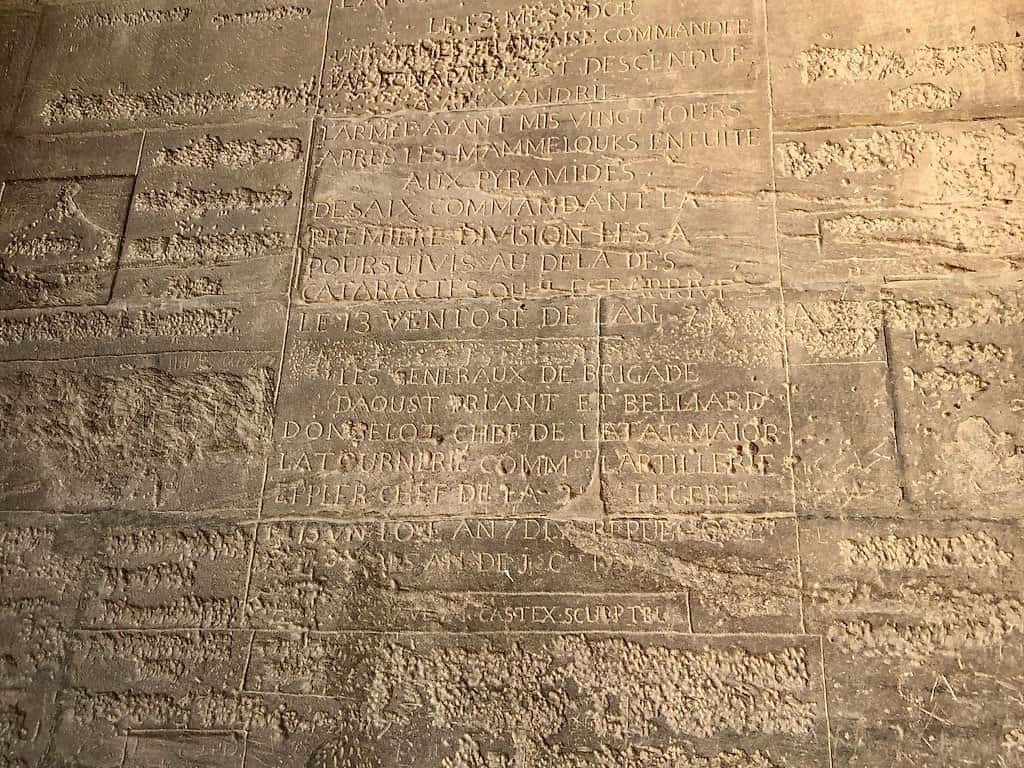
The First Pylon of the Temple of Philae / How to Visit and What to See at the Temple of Philae
These inscriptions bear witness to the interplay of cultures and civilizations that have left their mark on this sacred sanctuary over the ages, transforming it into the historical gem we behold today.
The Forecourt and the Birth House (Mammisi)
Welcome to the Forecourt and the Birth House (Mammisi) of the Temple of Philae, where the tapestry of ancient Egyptian mythology and artistry weaves a mesmerizing narrative.
The Forecourt, a tranquil expanse framed by graceful colonnades, is a visual feast for the senses. Each column is crowned with the serene visage of the goddess Hathor, an enchanting detail that underscores her revered presence within these sacred precincts.
On the western flank of the forecourt stands the Birth House, or Mammisi, a testament to maternal devotion and the enduring legacy of goddess Isis. This edifice was constructed as an homage to the birth of her beloved son, Horus, the deity associated with kingship, protection, and the sky.
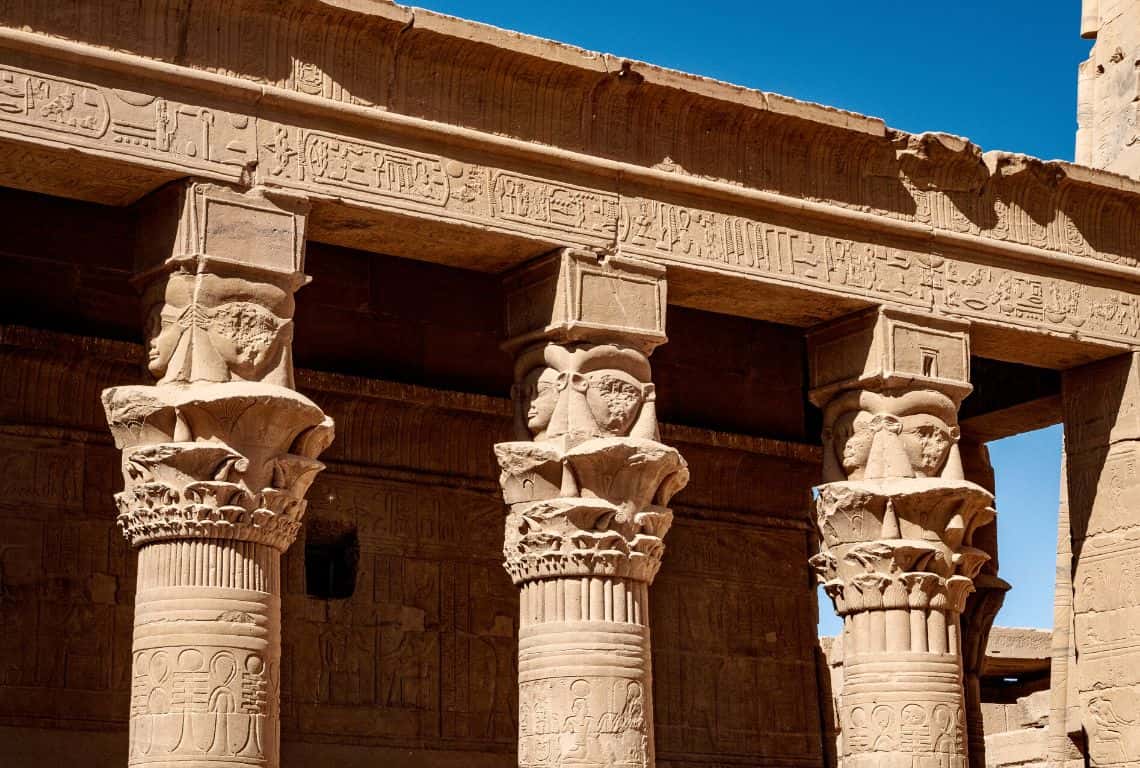
The Forecourt and the Birth House (Mammisi) / How to Visit and What to See at the Temple of Philae
Step inside, and you will find an exquisite array of reliefs adorning the walls, each one a tableau depicting scenes from the early life of Horus.
These captivating reliefs offer a glimpse into the mythical narrative that surrounded Horus’ childhood, enriching our understanding of the deep-rooted symbolism and beliefs that permeated ancient Egyptian culture.
Here, history melds seamlessly with the divine, creating an atmosphere that resonates with the spiritual and historical significance of this sacred space.
The Second Pylon
Now, as we advance further into the Temple of Philae, we encounter the Second Pylon—an architectural marvel that eclipses even the grandeur of its predecessor, the First Pylon.
What sets the Second Pylon apart is not only its monumental scale but also a captivating twist in its orientation. Unlike the First Pylon, this gateway is strategically angled towards the east, imparting a distinctive character to the temple complex as a whole.
A fascinating insight into the historical tapestry of the temple comes to light with the revelation that the reliefs adorning the Second Pylon bear the signature of Euergetes II.
This name might initially elicit curiosity, as historical connections may not readily spring to mind. However, upon closer examination, it becomes evident that Euergetes II refers to none other than Ptolemy VIII, renowned as Ptolemy VIII Euergetes II.
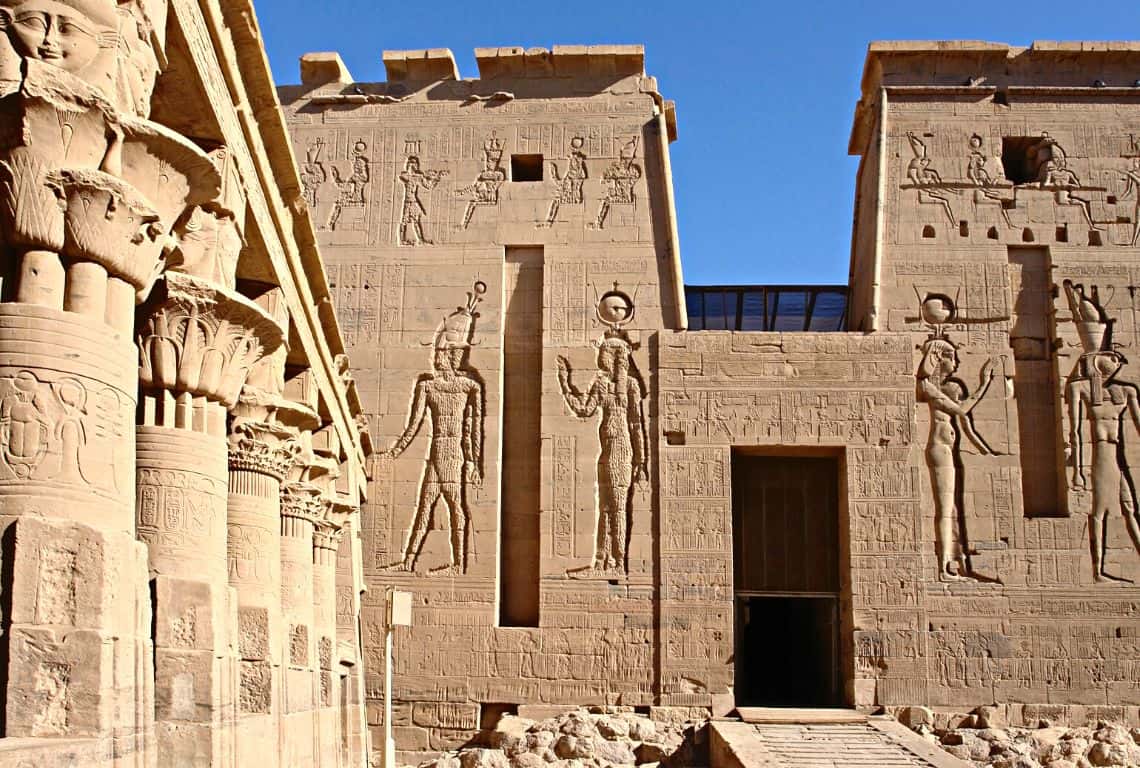
The Second Pylon / How to Visit and What to See at the Temple of Philae
Ptolemy VIII Euergetes II was a prominent figure in the Ptolemaic dynasty’s lineage, known for his multifaceted rule and contributions to Egyptian history.
His association with the reliefs on the Second Pylon underscores the enduring impact of the Ptolemaic dynasty on the Temple of Philae.
As we delve deeper into the temple’s chambers and courtyards, we continue to unravel the rich historical layers that have shaped this iconic sanctuary over the millennia.
The Vestibule
Step into the sacred realm beyond the Second Pylon, where you will find yourself in the Vestibule—a space of profound significance within the Temple of Philae, also known as a hypostyle hall.
Here, your senses will be awakened by the awe-inspiring craftsmanship that adorns this chamber.
Eight majestic columns rise before you, each a testament to the skill and artistry of the ancient builders. Their imposing presence and intricate details serve as a tangible reminder of the devotion and reverence that infused every stone of this hallowed sanctuary.
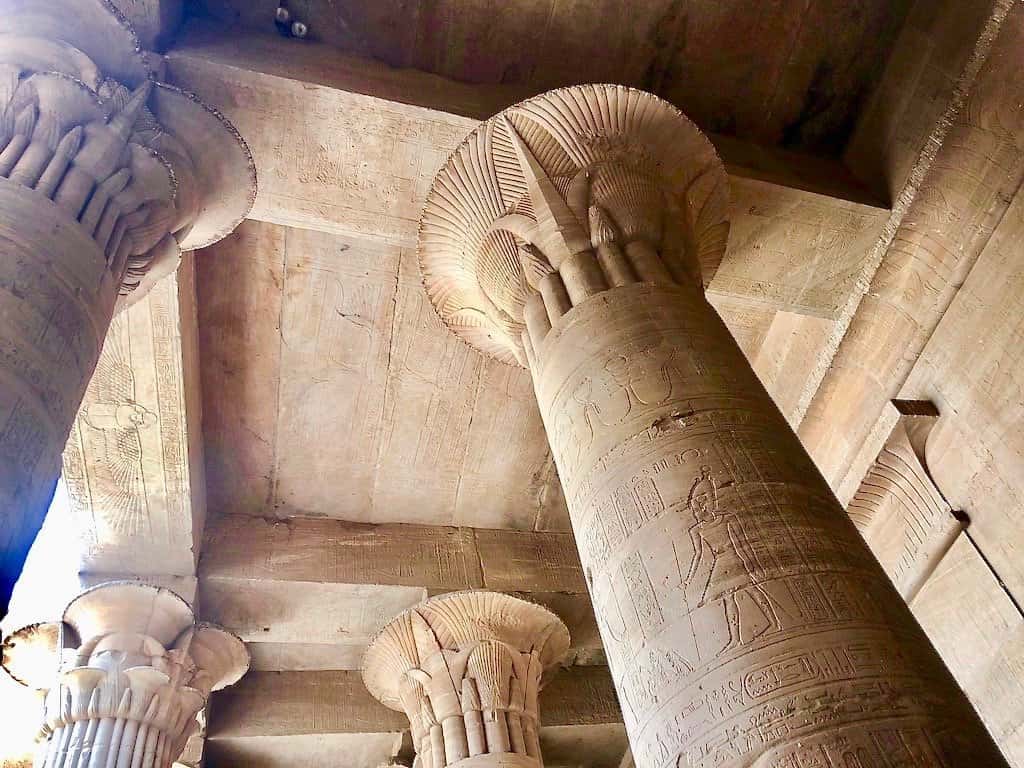
The Vestibule / How to Visit and What to See at the Temple of Philae
Direct your gaze upward, and you will discover a remarkable tableau on the ceiling.
Delicate reliefs depict vultures, not merely as creatures of the sky but as powerful symbols of protection for Upper Egypt, guarding the sacred space below.
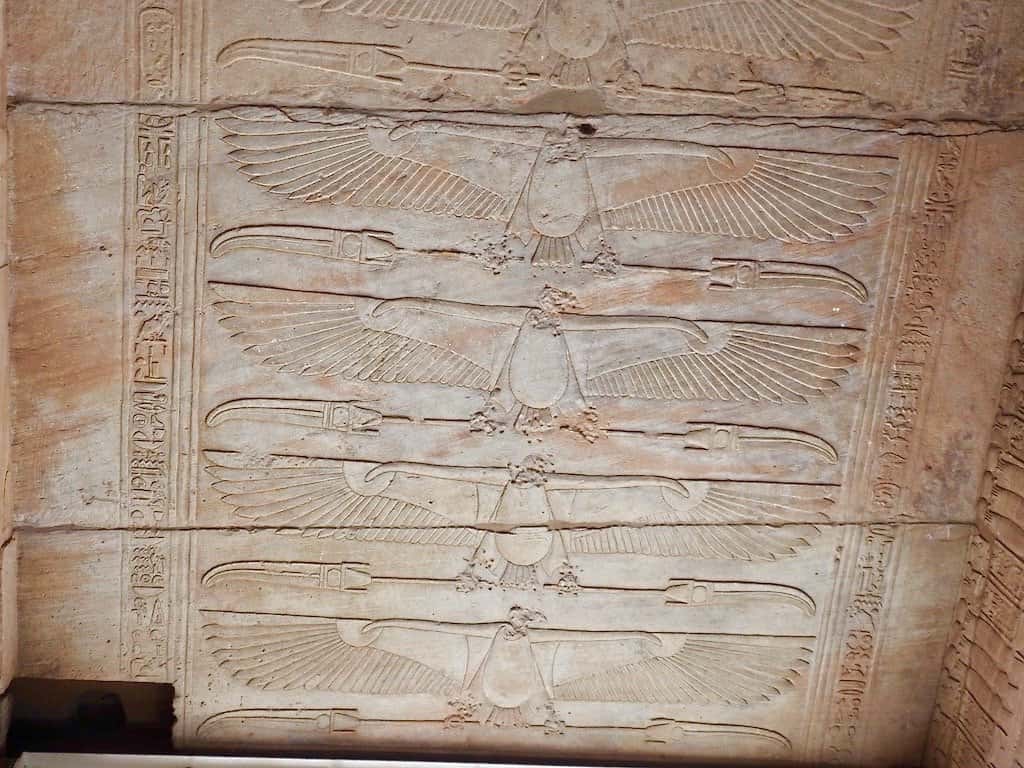
The Vestibule / How to Visit and What to See at the Temple of Philae
Yet, the Vestibule holds more than just artistic marvels—it carries the imprint of history’s transformative touch.
As you explore its corners, you will encounter subtle yet poignant reminders of the temple’s evolution.
Coptic crosses etched into the stone bear witness to a chapter in the temple’s journey when it transitioned into a place of Christian worship.
These crosses illuminate the enduring adaptability of this ancient site, as it embraced new beliefs and found fresh purpose in the changing tides of time.
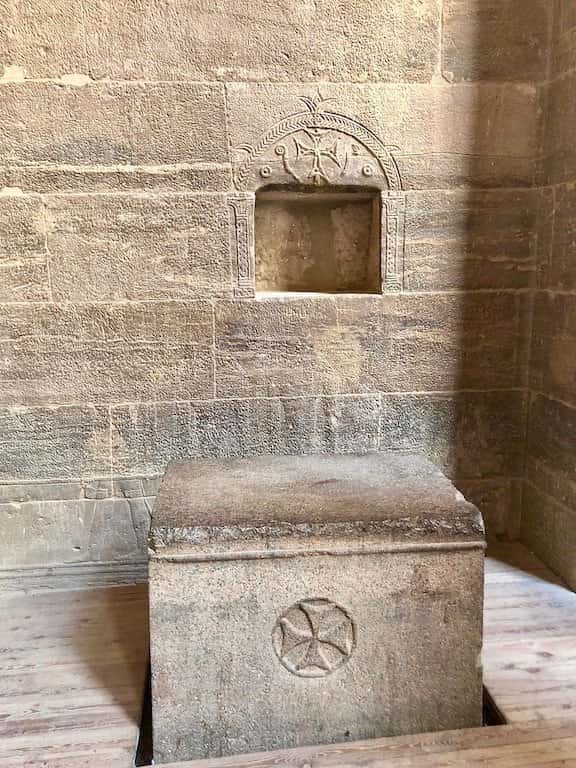
The Vestibule / How to Visit and What to See at the Temple of Philae
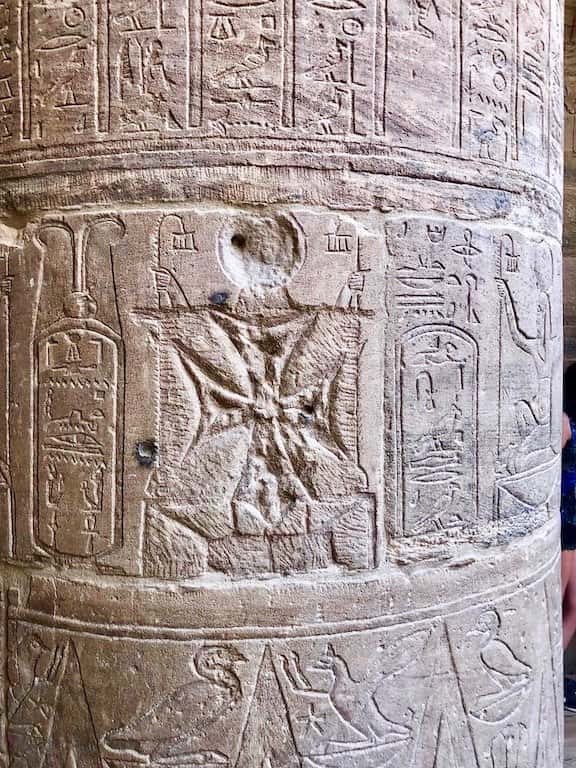
The Vestibule / How to Visit and What to See at the Temple of Philae
The Sanctuary of the Temple of Isis
To reach the inner sanctum dedicated to the revered goddess Isis within the Temple of Philae, one must traverse a path through three successive antechambers, each imbued with layers of history and spirituality.
At the heart of the sanctuary, a solemn pedestal stands as a poignant reminder of the sacred relics that once graced this hallowed space.
This sturdy platform once cradled the venerated statue of the goddess Isis and the divine barque in which she embarked on her mystical journeys.
Alas, the passage of time has separated these treasures from their ancestral home. The statue of Isis is said to now reside in the city of Paris, while the barque finds itself in Florence, Italy. Despite this knowledge, their precise locations within these cities remain elusive, shrouding their current whereabouts in a veil of mystery.
The journey through these chambers not only unveils the temple’s rich history but also underscores the enduring allure of goddess Isis and the lasting resonance of her worship beyond the confines of Philae’s sanctuary.
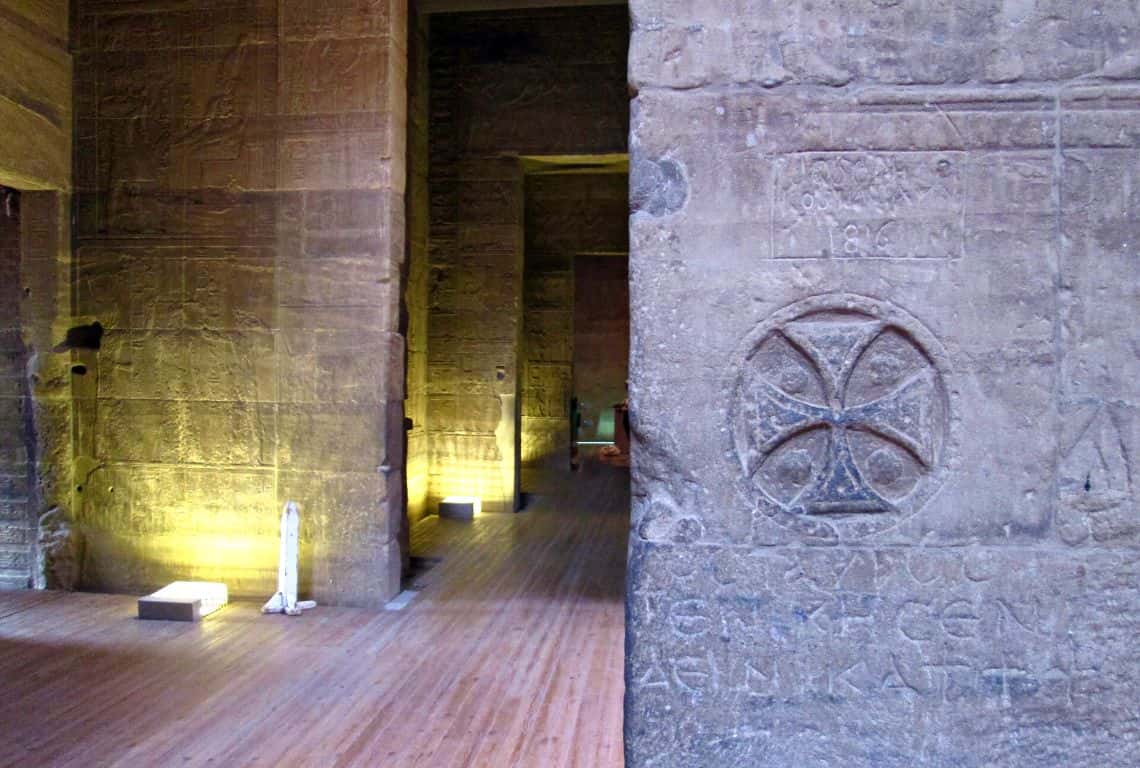
The Sanctuary of the Temple of Isis / How to Visit and What to See at the Temple of Philae
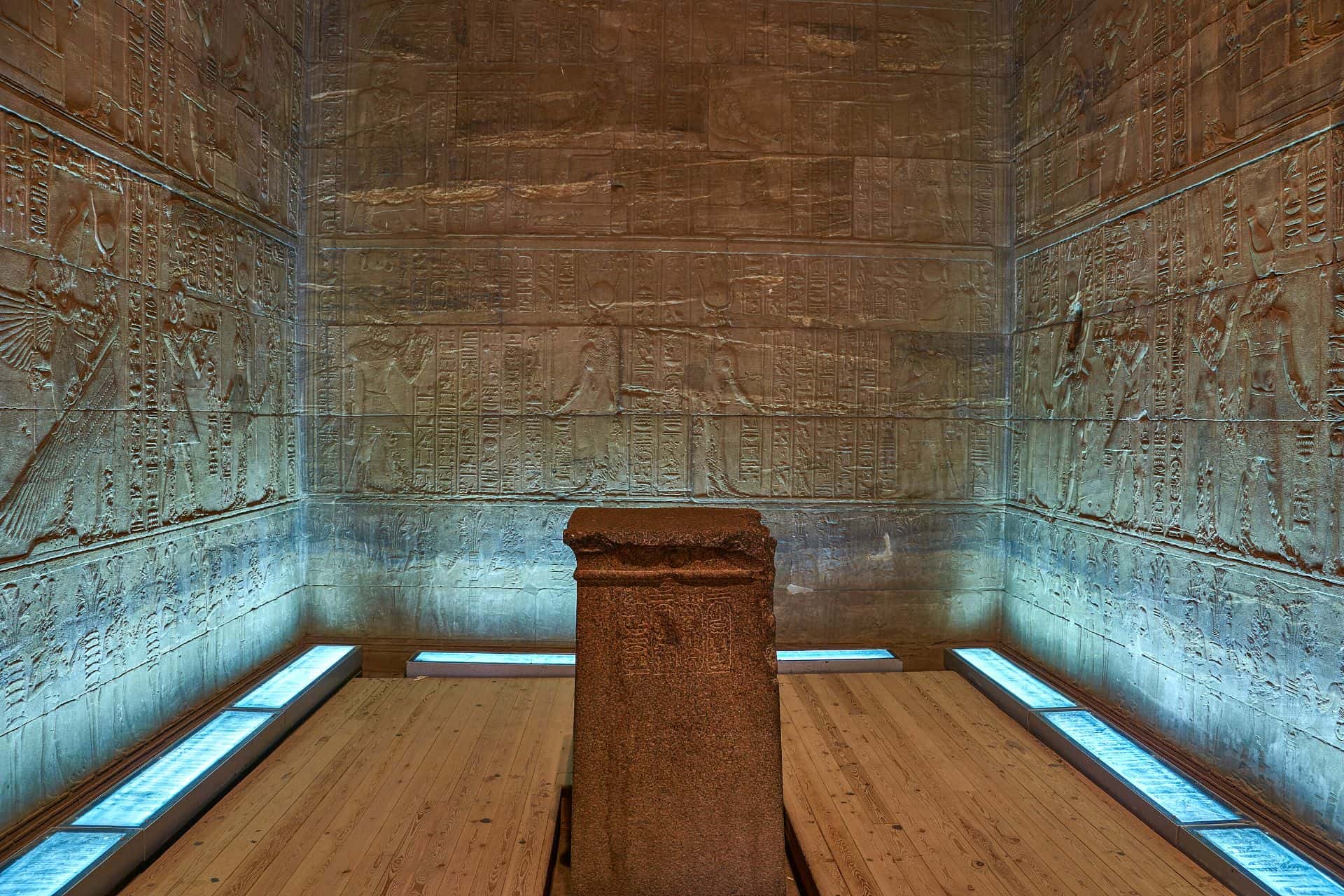
The Sanctuary of the Temple of Isis / How to Visit and What to See at the Temple of Philae
The Temple of Hathor
Make sure not to overlook the enchanting Temple of Hathor during your exploration of Philae Island. This hidden gem is nestled on the island’s eastern side and carries a rich history intertwined with the rule of Ptolemy VI Philometor and Ptolemy VIII Euergetes II.
The temple itself is a testament to the artistry of its time, boasting intricate designs and a picturesque location overlooking the tranquil waters that surround Philae Island.
Prepare your camera, for the captivating views from this vantage point will undoubtedly beckon you to capture the moment.
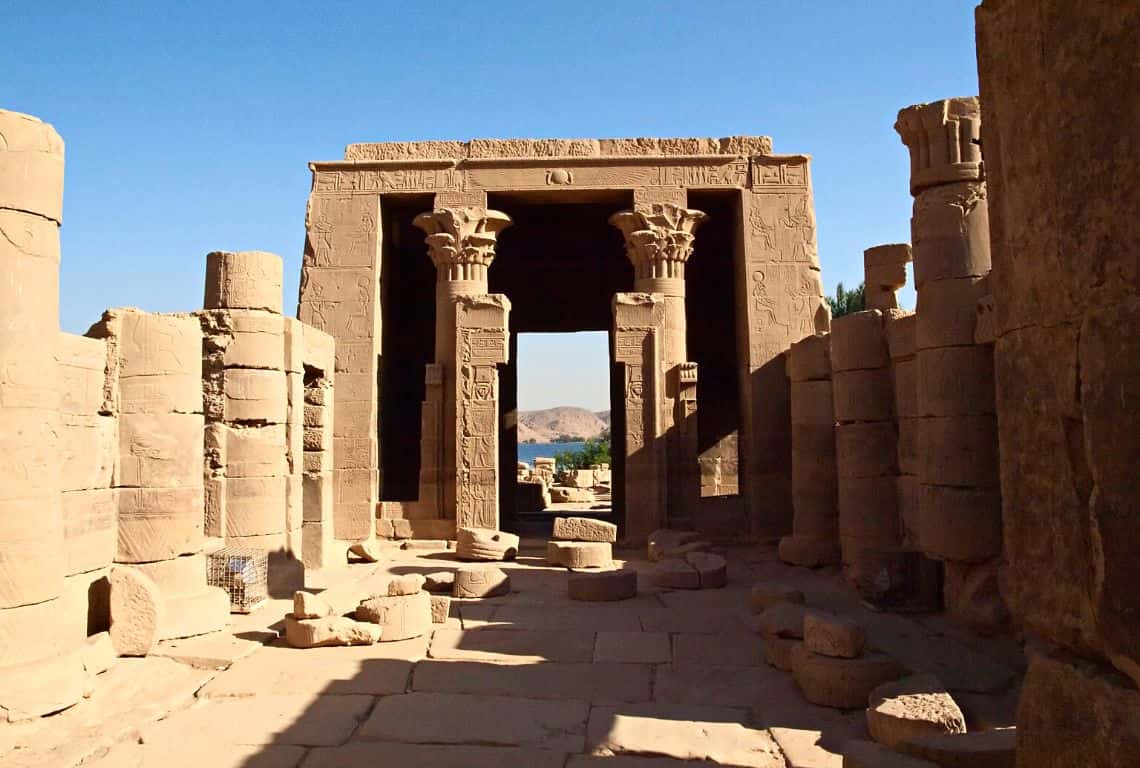
Temple of Hathor / How to Visit and What to See at the Temple of Philae
As you journey further beyond the Temple of Hathor, you will encounter a unique collection of large stone blocks adorned with reliefs depicting the god Bes.
Bes, known as Bisu or Aha in ancient Egypt, is a deity of captivating complexity.
At once a god and a formidable defender, he embodies a duality that extends from the realm of warfare to that of childbirth and the domestic sphere.
His influence extends to matters of sexuality, humor, music, and dance, rendering him a deity with a multifaceted role in the lives of the ancient Egyptians.
Despite his origins as a protector of pharaohs, Bes garnered immense popularity among the everyday people of Egypt. His enduring appeal lay in his unwavering guardianship of women and children, making him a beloved figure in households throughout the land.
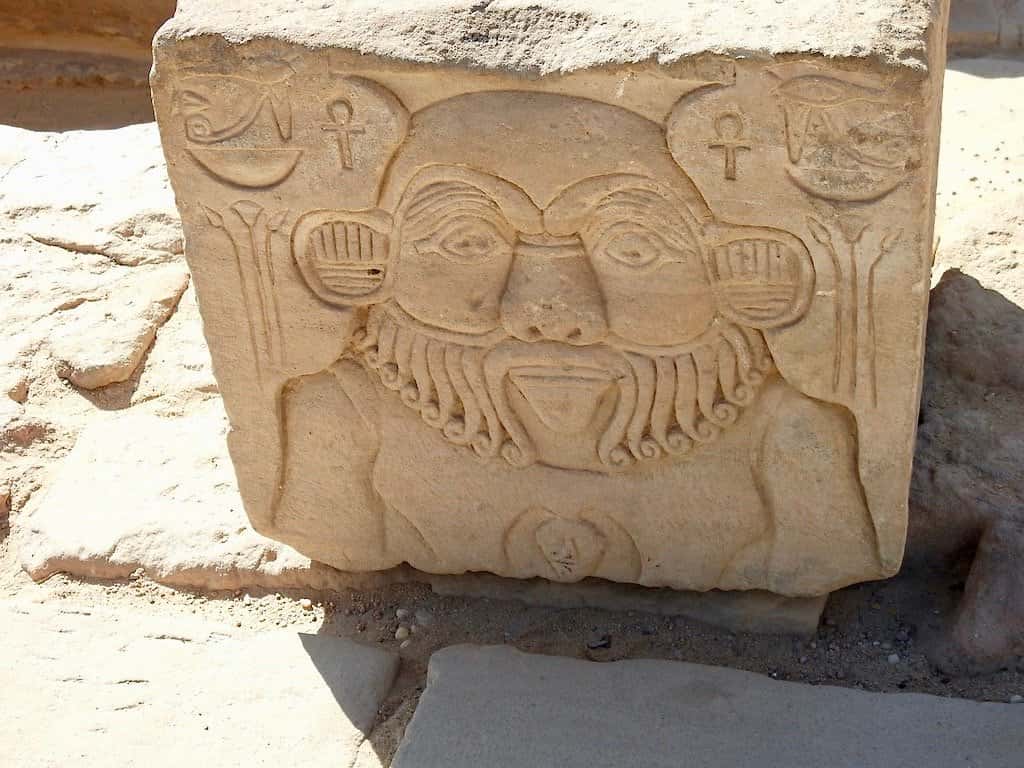
Relief of god Bes / How to Visit and What to See at the Temple of Philae
Surprisingly, Bes had no dedicated temples, and no priests held ordination in his name. Nevertheless, his presence graced a multitude of household items, from furniture to mirrors, cosmetics containers, and applicators, as well as magical wands and knives.
This omnipresence made him one of the most cherished deities of ancient Egypt, a testament to his enduring significance in the hearts and homes of the people.
The Kiosk of Trajan (Pharaoh's Bed)
Behold the captivating Kiosk of Trajan, a marvel often referred to as the “Pharaoh’s Bed.” This splendid structure is composed of 14 imposing columns linked by intricately designed screen walls, a testament to the artistic finesse of its time.
These colossal columns are adorned with exquisitely carved floral capitals, each a work of art in its own right.
Venturing within, you will be transported through time as you encounter reliefs that depict Trajan, the Roman emperor who reigned from 98 to 117 AD, assuming the mantle of a pharaoh.
These intricate scenes showcase Trajan in the act of making offerings to the revered Egyptian deities Osiris, Isis, and Horus, illustrating a fusion of Roman authority with the ancient Egyptian pantheon.

The Kiosk of Trajan / How to Visit and What to See at the Temple of Philae
Trajan’s reign marked a pivotal era in Roman history. He presided over the empire during a period of unprecedented military expansion, leading Rome to attain its zenith in territorial extent by the time of his passing.
Beyond his military accomplishments, Trajan is celebrated for his philanthropic governance, characterized by extensive public building programs and groundbreaking social welfare policies.

The Kiosk of Trajan / How to Visit and What to See at the Temple of Philae
As you explore the Kiosk of Trajan, you not only immerse yourself in the architectural splendor of the past but also connect with the enduring legacy of a ruler whose reign left an indelible mark on the Roman Empire.
This fusion of cultures and historical significance adds a profound layer of depth to your visit to the Temple of Philae, where the echoes of history resonate through each meticulously carved stone.
Intrepid Scout's Tips for How to Visit and What to See at the Temple of Philae
- Is the Temple of Philae worth visiting? If you are wondering if it is worth visiting the Temple of Philae? The answer is: yes! It is one of the most beautiful temples in Egypt. Plus, taking a boat to the Island of Agilkia where the temple is located makes the entire visit even more special.
- Get there early, if you are visiting during the summer months. The majority of the time you will be spending outdoors. Make sure to have water, wear a hat, and layer on some sunscreen!
- Traveling in Egypt can be challenging, even for the most seasoned nomad. There’s so much to know about Egypt and consider before planning a trip, however, make sure to read 14 Egypt travel tips, to help you make the most of your time, avoid possible challenges, and ensure you have a safe and enjoyable stay in Egypt.
14 Egypt Travel Tips to Save You Time, Money, and Keep You Safe
You Might Also Like:
How to Visit and What to See at KHAN EL-KHALILI BAZAAR in Cairo
Perfect 7-Day Egypt Itinerary for First Visit (Cairo, Aswan, Luxor, Abu Simbel)
What to See at the TEMPLE of HORUS at EDFU (5 Things You Can’t Miss)
What to See at the TEMPLE of KOM OMBO, Egypt (9 Things You Can’t Miss)
How to Visit Abu Simbel: Everything You Need to Know to Plan Your Visit
How to Visit and What to See at the TEMPLE of PHILAE in Aswan
Best Day Trip from Cairo – Dahshur, Memphis, and Saqqara (Maps+Photos)
19 Must-See Things at Egyptian Museum in Cairo (+Practical Tips)
Did You Find What to See at the Temple of Philae Useful?
Why not save it to your Pinterest board!
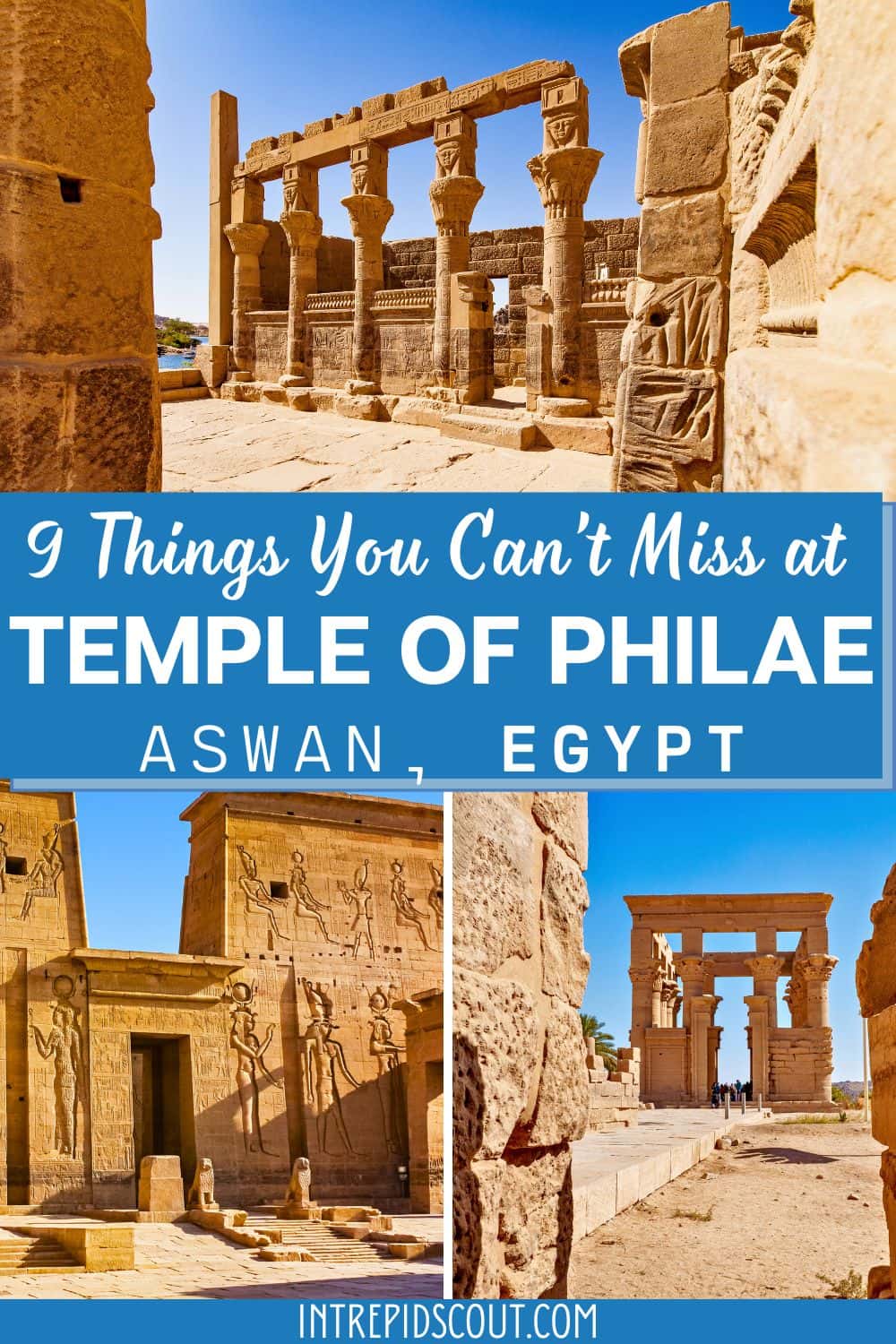
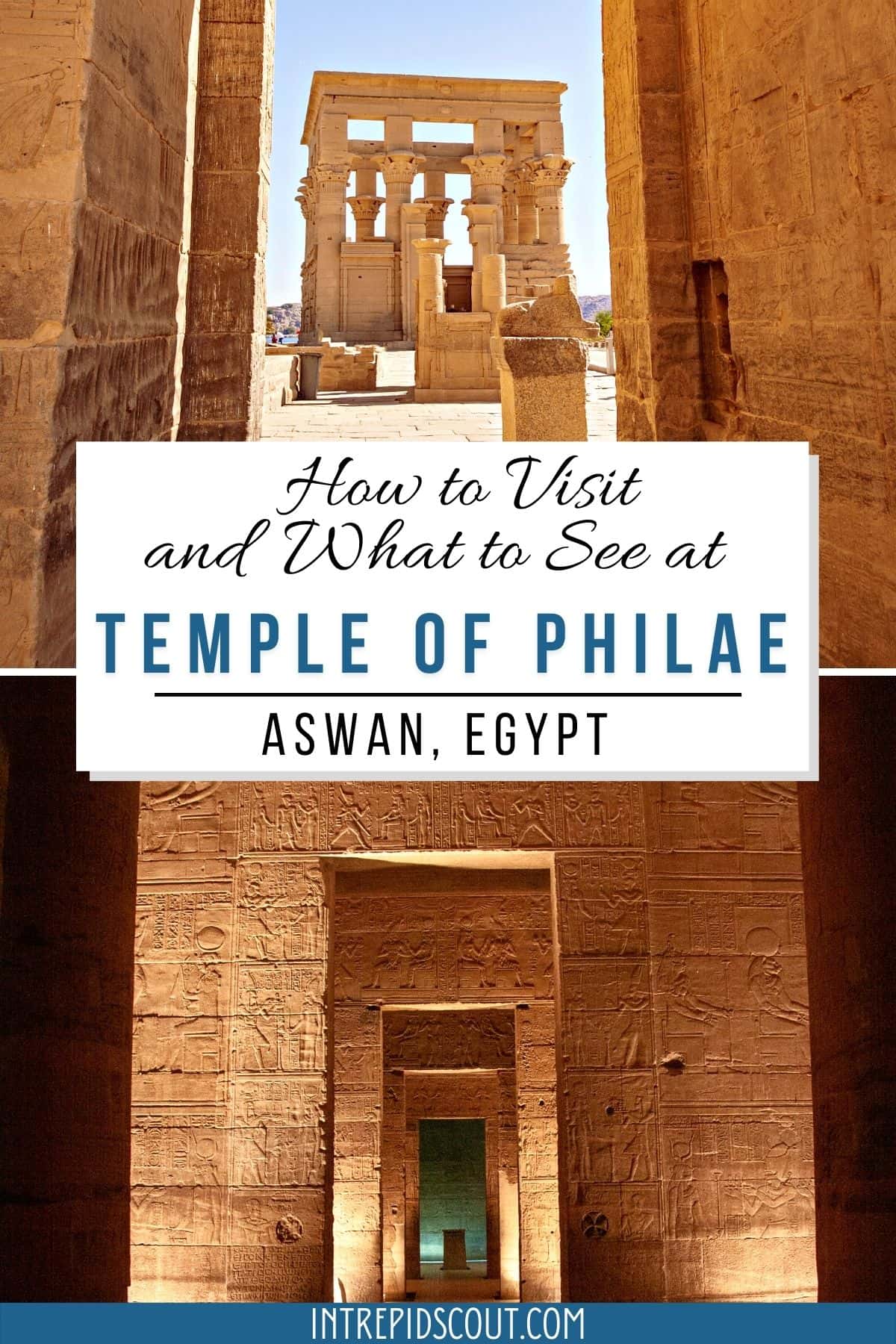
Now, It Is Your Turn, I Would Like to Hear Back from You!
Are you planning on visiting the Temple of Philae in Aswan?
Please let me know! Drop me a quick comment right below!
Also, click on any of the images below to get inspired and to help you with the planning process for your trip to Egypt!
